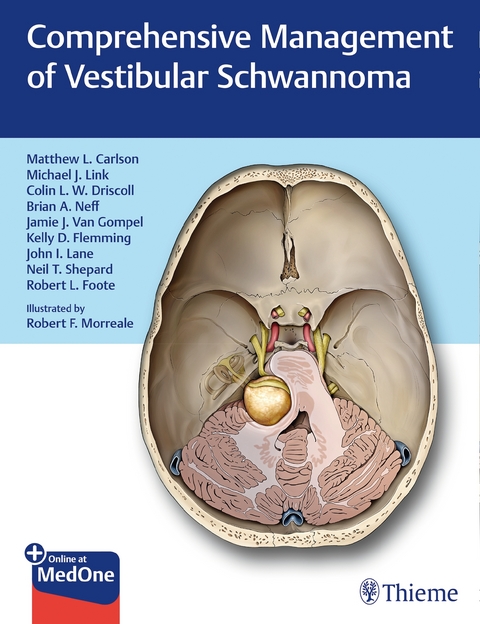
Comprehensive Management of Vestibular Schwannoma
Thieme Medical Publishers Inc (Verlag)
978-1-62623-331-7 (ISBN)
Although a histologically benign and relatively uncommon tumor, otolaryngologists and neurosurgeons have maintained a lasting and deep-rooted fascination with vestibular schwannoma, also known as acoustic neuroma. Advancements in microsurgical technique, radiosurgery, and radiotherapy, coupled with an increased understanding of the natural history of the disease, have made modern management of this tumor considerably more complex. Concurrently, new controversies have added to the original debates among pioneering surgeons, with the pendulum swinging between conservatism and definitive cure.
»Comprehensive Management of Vestibular Schwannoma«, by distinguished Mayo Clinic clinicians and renowned international contributors, is a comprehensive textbook covering all the clinical aspects of vestibular schwannoma management. Eighty-four chapters written by multidisciplinary experts including otolaryngologists, neurosurgeons, radiation oncologists, neurologists, neuroradiologists, and audiologists, ensure a balanced view of all treatment modalities for sporadic and neurofibromatosis type 2-associated vestibular schwannoma.
Key Features:
- Evaluation, surgical and nonsurgical approaches, rehabilitation, controversies, and long-term clinical outcomes
- Detailed illustrations by Robert Morreale, senior medical illustrator at the Mayo Clinic, highlight relevant anatomy and surgical approaches
- Chapter summary tables provide readers with a rapid clinical reference derived from the published world literature
- The chapter "Anatomy of Vestibular Schwannoma Surgery" by the late internationally renowned neurosurgeon Albert L. Rhoton Jr. reflects his major contributions on this subject
With inclusion of fundamental principles to advanced concepts, this is a robust resource for residents, fellows, and early attending physicians, as well as mid- to later-career physicians who care for patients with vestibular schwannoma.
This book includes complimentary access to a digital copy on https://medone.thieme.com.
Section I. Background
1 History of Vestibular Schwannoma Surgery
2 Historical Development of Radiation Modalities for Vestibular Schwannoma
3 Epidemiology of Vestibular Schwannoma
4 Histopathology of Vestibular Schwannoma
5 Molecular Biology of Sporadic and NF2-Associated Vestibular Schwannoma
Section II. Disease Presentation and Diagnostic Evaluation
6 Disease Presentation of Sporadic Vestibular Schwannoma
7 Auditory and Vestibular Testing Relevant to Vestibular Schwannoma
8 Diagnostic Imaging of Sporadic Vestibular Schwannoma and Other CPA Lesions
9 Emerging Imaging Techniques in Vestibular Schwannoma
10 MRI Safety and Imaging Quality in Patients with Cochlear Implants or Auditory Brainstem Implants with Retained Internal Magnets
Section III. Management: Overview
11 Current Trends in Vestibular Schwannoma Management
12 Multidisciplinary Care of the Vestibular Schwannoma Patient: Building a Skull Base Team
13 Patient Counseling Following Diagnosis of Sporadic Vestibular Schwannoma
Section IV. Management: Conservative Observation
14 Natural History of Tumor Growth in Sporadic Vestibular Schwannoma
Section V. Management: Radiation
15 Principles of Radiobiology Relevant to Radiosurgery and Radiotherapy of Sporadic Vestibular Schwannoma
16 Gamma Knife Radiosurgery for Treatment of Sporadic Vestibular Schwannoma
17 Linear Accelerator Radiosurgery for Treatment of Vestibular Schwannoma (Non-CyberKnife)
18 Conventional Fractionation LINAC-based Stereotactic Radiotherapy for Treatment of Sporadic Vestibular Schwannoma
19 CyberKnife Radiotherapy for Treatment of Sporadic Vestibular Schwannoma
20 Proton Beam Radiotherapy for Treatment of Sporadic Vestibular Schwannoma
21 Secondary Radiation Treatment of Vestibular Schwannoma After Prior Microsurgery or Radiosurgery
22 Radiation Therapy and Stereotactic Radiosurgery for Large Vestibular Schwannoma
23 Complications of Radiosurgery and Fractionated Radiotherapy for Vestibular Schwannoma
24 Risk of Radiation Associated Tumorigenesis in the Treatment of Vestibular Schwannoma
25 Imaging Follow-Up After Radiosurgery of Vestibular Schwannoma
Section VI. Management: Microsurgery
26 General Anesthesia in Vestibular Schwannoma Surgery
27 Intraoperative Facial Nerve Monitoring During Vestibular Schwannoma Microsurgery
28 Intraoperative Eighth Nerve Monitoring During Vestibular Schwannoma Microsurgery
29 Training in Vestibular Schwannoma Microsurgery
30 Anatomy of Vestibular Schwannoma Surgery
31 Surgical Approach Selection for Vestibular Schwannoma Microsurgery
32 Management of the Facial Nerve During Vestibular Schwannoma Microsurgery
33 Translabyrinthine Approach for Vestibular Schwannoma Resection
34 Surgical Refinements to the Translabyrinthine Approach to the Cerebellopontine Angle
35 Retrosigmoid Approach for Medium to Large Vestibular Schwannoma
36 Retrosigmoid Approach for Hearing Preservation Vestibular Schwannoma Microsurgery
37 Middle Cranial Fossa Approach for Hearing Preservation Vestibular Schwannoma Microsurgery
38 Transotic Approach for Vestibular Schwannoma Resection
39 Transcanal Transpromontorial Endoscopic Approach for Vestibular Schwannoma Resection
40 Endoscopic Vestibular Schwannoma and Lateral Skull Base Surgery
41 Subtotal Resection of Sporadic Vestibular Schwannoma
42 Staged Resection of Large Vestibular Schwannoma
43 Microsurgery for Recurrent and Residual Vestibular Schwannoma
44 Salvage Microsurgery After Radiation Treatment of Vestibular Schwannoma
45 Avoidance and Management of Vascular Complications During Vestibular Schwannoma Surgery
46 Perioperative Management of Hydrocephalus
47 Postoperative Cerebrospinal Fluid Leak, Pseudomeningocele, and Meningitis: Risks, Avoidance, and Treatment
48 Postoperative Counseling, Restrictions, and Care
49 Postoperative Imaging Surveillance Following Vestibular Schwannoma Resection
Section VII. Treatment Outcomes
50 Reporting of Hearing Outcome Data for Vestibular Schwannoma
51 Natural History of Hearing and Vestibular Function in Untreated Sporadic Vestibular Schwannoma
52 Hearing and Vestibular Function Loss After Radiation Treatment of Sporadic Vestibular Schwannoma
53 Results of Hearing Preservation Microsurgery for Sporadic Vestibular Schwannoma
54 Reporting of Facial Nerve Outcome Data for Vestibular Schwannoma
55 Facial Nerve Injury in Sporadic Vestibular Schwannoma: Mechanisms, Predictors, and Outcomes
56 Patient Self-Assessment of Symptom Disability and Handicap in Vestibular Schwannoma
57 Tinnitus in Sporadic Vestibular Schwannoma
58 Dizziness in Sporadic Vestibular Schwannoma
59 Epidemiology and Pathogenesis of Headache in Patients with Vestibular Schwannoma
60 Quality-of-Life Outcomes in Sporadic Vestibular Schwannoma
Section VIII. Medical and Surgical Rehabilitation
61 Auditory Rehabilitation in Sporadic Vestibular Schwannoma
62 Non-Operative Facial Rehabilitation in Vestibular Schwannoma: Facial Neuromuscular Retraining
63 Medical and Surgical Care of the Eye in Facial Paralysis
64 Interposition Cable Nerve Graft of the Facial Nerve After Resection of Vestibular Schwannoma
65 Hypoglossal-to-Facial Nerve Transfer with Parotid Release for Rehabilitation of the Paralyzed Face in Vestibular Schwannoma
66 V3 Masseteric Branch Reinnervation for Rehabilitation of the Paralyzed Face in Vestibular Schwannoma
67 Gracilis Free Flap Rehabilitation of the Paralyzed Face in Vestibular Schwannoma
68 Static Procedures for Rehabilitation of the Paralyzed Face in Vestibular Schwannoma
69 Vestibular Rehabilitation and "PreHab" in Sporadic Vestibular Schwannoma
70 Management of Pre- and Post-Treatment Trigeminal Neuralgia in Vestibular Schwannoma
71 Postoperative Headache: Clinical Evaluation and Treatment in Patients Undergoing Surgery for Vestibular Schwannoma
72 The Acoustic Neuroma Association and Social Aspects of Support Group Care for Patients with Vestibular Schwannoma
Section IX. Controversial or Challenging Aspects of Care
73 Management of Small Vestibular Schwannoma in Patients with Minimal Symptoms
74 What is the Best Treatment for Small to Medium-Sized Vestibular Schwannoma?
75 Management of Sporadic Vestibular Schwannoma in the Only Hearing Ear
76 Treatment of Cystic Vestibular Schwannoma
77 Primary Inner Ear (Intralabyrinthine) Schwannomas
Section X. Neurofibromatosis Type 2
78 Genetics of Neurofibromatosis Type 2
79 Diagnosis and Evaluation of Neurofibromatosis Type 2
80 Natural History of Vestibular Schwannoma Growth and Hearing in Neurofibromatosis Type 2
81 Microsurgery for Neurofibromatosis Type 2 Focusing on Vestibular Schwannoma
82 Radiosurgery and Radiotherapy for Neurofibromatosis Type 2 Focusing on Vestibular Schwannoma
83 Medical Therapy for Neurofibromatosis Type 2 Focusing on Vestibular Schwannoma
84 Auditory Rehabilitation in Neurofibromatosis Type 2
| Erscheinungsdatum | 21.06.2019 |
|---|---|
| Zusatzinfo | 441 Abbildungen |
| Verlagsort | New York |
| Sprache | englisch |
| Maße | 279 x 216 mm |
| Gewicht | 1 g |
| Einbandart | gebunden |
| Themenwelt | Medizinische Fachgebiete ► Chirurgie ► Neurochirurgie |
| Medizin / Pharmazie ► Medizinische Fachgebiete ► HNO-Heilkunde | |
| ISBN-10 | 1-62623-331-4 / 1626233314 |
| ISBN-13 | 978-1-62623-331-7 / 9781626233317 |
| Zustand | Neuware |
| Informationen gemäß Produktsicherheitsverordnung (GPSR) | |
| Haben Sie eine Frage zum Produkt? |
aus dem Bereich


